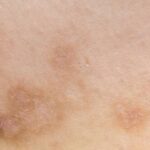
Managing Chronic Skin Conditions When Life Gets Busy
August 18, 2025
Prurigo Nodularis: Understanding the Disease Behind the Itch That Won’t Quit
October 16, 2025Living with palmoplantar pustulosis (PPP) can feel overwhelming. The painful, burning blisters on the hands and feet make even simple daily activities—like walking, driving, cooking, or holding a pen—feel impossible. For many, the constant cycle of eruptions means missed work, social isolation, and an exhausting search for relief that never seems to last.
PPP is considered a rare psoriasis subtype, yet it can also appear in people who have never experienced plaque psoriasis, making it a separate clinical diagnosis in some cases. No matter how it develops, it is a painful condition that severely impacts patients’ and their families’ quality of life. People with PPP are often essentially disabled because the cracked, sore skin lesions prevent them from being able to walk or use their hands.
Apex Clinical Research Center is currently pioneering PPP treatment dermatology clinical trials to help people struggling with palmoplantar pustulosis get more effective, longer-lasting relief.
What Is Palmoplantar Pustulosis?
Palmoplantar pustulosis (PPP) is a rare, inflammatory autoimmune skin disease, the causes of which have not yet been discovered. The name of this skin disease indicates both the type of lesions it causes and the area of the body that it affects. The blister-like lesions are called “pustules”. The word “palmo” refers to the palms of the hands, while plantar refers to the soles of the feet.
Palmoplantar Pustulosis Symptoms
PPP is characterized by the following difficult symptoms:
- Painful, sterile pustules on the palms and soles
- Thickened, cracked, or scaly skin
- Redness, itching, burning, and skin peeling
- Cycles of flare-ups and remissions
Because PPP affects the soles of the feet, flare-ups can make it difficult for patients to walk without pain. Lesions on the palms of the hands can make it hard to grasp items or do normal things such as grasp a glass of water to drink, hold on to a steering wheel while driving, or even pick up a book without pain. It is a functionally disabling and emotionally distressing condition that severely hampers the quality of life for those who have PPP.
What Do PPP Patients Have in Common?
Although palmoplantar pustulosis statistics are hard to track, some studies estimate that approximately 0.12% of the global population has been affected. A range of studies, however, have discovered some commonalities about who is most at risk for PPP:
- Palmoplantar pustulosis seems to be a rare subtype of psoriasis—about 24% of patients with PPP also have psoriasis, or have family members who have it. There are, however, many PPP patients who have never had a separate diagnosis of psoriasis.
- More women are diagnosed with PPP than men, and it is exceedingly rare in children.
- Strikingly, 95% of patients with palmoplantar pustulosis are, or have been, smokers, indicating that smoking can trigger the condition.
- There may be a genetic component to PPP, as people who have a diagnosis are more likely to have family members who also have the condition.
- Palmoplantar pustulosis is also more common in patients who have the following disorders and conditions:
- Diabetes
- Arthritis
- Thyroid disorders
- Celiac disease
- Sensitivities to metals (especially nickel)
Stress, trauma, and some medications have also been known to cause flare-ups in patients with PPP. Although there seems to be a connection between psoriasis and palmoplantar pustulosis, it’s important to note that PPP is a separate and distinct diagnosis from pustular psoriasis, which can cause painful pustules anywhere on the body, not just the palms of your hands or the soles of your feet.
Diagnosis and Current PPP Disease Treatment Limitations
Your healthcare provider can diagnose PPP by doing a thorough physical exam to observe the symptoms you’re experiencing. They will also ask about your medical and family history. Sometimes clinicians will take a small biopsy or swab sample of the area to run labs and examine the sample under a microscope to confirm an official palmoplantar pustulosis. These tests rule out other possible diagnoses, such as fungal infections, dyshidrotic eczema, or pustular psoriasis. Effective PPP treatment depends on your healthcare provider arriving at the correct diagnosis.
Current PPP Treatment Options
There is currently no cure for PPP, although there are several current treatment options that can provide relief. Ongoing dermatology research studies are working to find more effective, easily tolerated treatments as well, like the Apex Clinical Research Center clinical trial. Some of the most common PPP disease treatment options currently include:
- Topical corticosteroids—Your healthcare provider may prescribe topical steroid creams to help relieve inflammation, itchiness, pain, and tenderness.
- Coal tar ointment—This can help relieve the itchiness of the pustules, helping them to heal faster. It also slows down skin cell production to prevent thickening of the skin on the palms and soles.
- Topical Vitamin-D ointment—Often used in combination with topical corticosteroids, Vitamin-D topicals can also help reduce inflammation and promote skin healing.
- Phototherapy—Clinical, controlled doses of PUVA and UVB light can slow skin cell growth and help patients go into symptom remission for longer periods of time.
- Oral prescription medications—Systemic oral medications such as acitretin (made from vitamin A), methotrexate, and cyclosporine can provide temporary relief from PPP flare-ups, but each comes with significant risk of side effects, especially for patients of childbearing age.
- Biologics—Off-label psoriasis biologics medications like ustekinumab and secukinumab have also been used to treat palmoplantar pustulosis, but with mixed results so far. Biologics are derived from organic proteins that can potentially modulate and calm the immune responses connected to skin flare-ups.
Current PPP Treatment Limitations
Although each of these current PPP treatment options has a history of providing some relief, patients who have frequent flare-ups can experience unwanted side effects from using them long-term. Sometimes, it takes a long time for these treatments to kick in and produce the desired relief. In other cases, even when a patient has had success in the past with one of these treatments, recurring use of a medication for subsequent flare-ups can become less effective—a form of “treatment fatigue.” This leaves patients struggling with the frustrating, painful, and debilitating skin disease for longer periods of time. This is why Apex Clinical Research Center is working to find better, easier-to-use, longer-lasting PPP disease treatment options through our dermatology clinical trials.
Dermatology Research Advancements: PPP Clinical Trials
We are currently working on dermatology clinical trials for new PPP treatments and therapies, including the following:
- IL-23 inhibitors (e.g., guselkumab, risankizumab)
- IL-36 pathway targets
- Small molecule therapies (e.g., apremilast)
Potential Benefits
These palmoplantar pustulosis clinical trials aim to find and create pathways to faster symptom relief that reduce the frequency and severity of flare-ups. Another important thing we are looking for is treatments that are easier and more convenient for patients to apply. It’s also critical to find PPP treatments that last longer and are more easily tolerated for longer periods of time, so that periods of remission and relief last longer.
Why Dermatology Clinical Trials are Critical for PPP
Trying to relieve and lessen the severe struggle that palmoplantar pustulosis patients endure is the primary reason we are engaged in this dermatology research. PPP is a rare, underfunded, and underrepresented condition, but the people struggling with it are real and deserve to have relief and an improved quality of life. Clinical trials are often the only way for patients to access innovative and potentially more effective therapies. If you struggle with PPP, please reach out to us to discuss your eligibility for participating in clinical trials.
Eligibility Criteria for PPP Clinical Trial Participation
Our clinical trial to evaluate the efficacy and safety of a new PPP study drug in participants with palmoplantar pustulosis is a phase 3, randomized, double-blind, placebo-controlled, multicenter study with open-label extension. Eligibility criteria include:
- Participants must be adults aged 18 or older at screening. There is no upper age limit.
- You must have had a clinical diagnosis of palmoplantar pustulosis for at least 24 weeks before the screening visit.
- Participants may also have a history of concomitant plaque psoriasis if it is limited to less than or equal to 10% body surface area, and they cannot have plaque psoriasis on the palms and soles.
- Participants must have active PPP as indicated by pustules on the hands and/or soles of feet at screening and at baseline. There must be at least 5 active white-yellow pustules across all regions.
- The PPP diagnosis must be confirmed through photo adjudication.
- Participants may also be candidates for systemic or phototherapy.
- Women of childbearing potential must agree to use a highly effective method of contraception consistently and correctly.
If you are struggling with palmoplantar pustulosis and feel that you fit these criteria, please contact us today about participating in our PPP clinical trials.
A Better Future for PPP Treatment Through Dermatology Research
The Apex Clinical Research Center team is eager to help palmoplantar pustulosis patients. PPP is such a struggle and a burden, and current treatments are still limited in terms of long-term effectiveness and providing quick relief. Clinical trials are not a last resort; they are the future of treatment that can finally bring better, more effective, longer-lasting relief. Clinical trial participants receive intensive monitoring for safety and are at the forefront of discovering better care for themselves and others struggling with the same condition. Apex Clinical Research Center is running clinical trials for several different skin conditions, including PPP. If you have a palmoplantar pustulosis diagnosis, please reach out to us for an appointment to determine your eligibility to participate in our PPP clinical trial.


